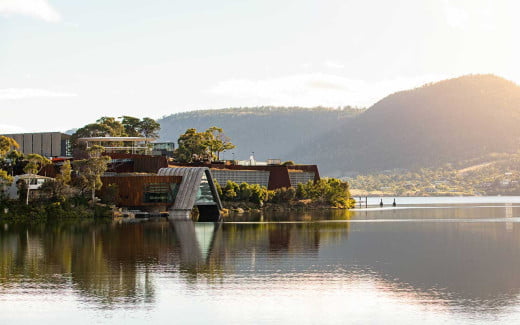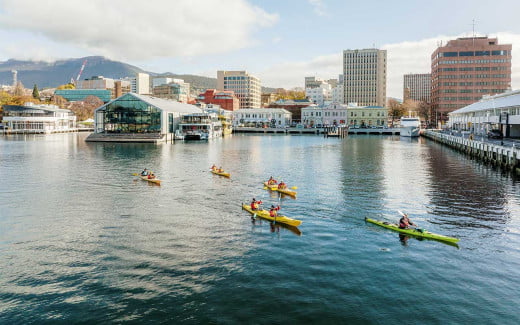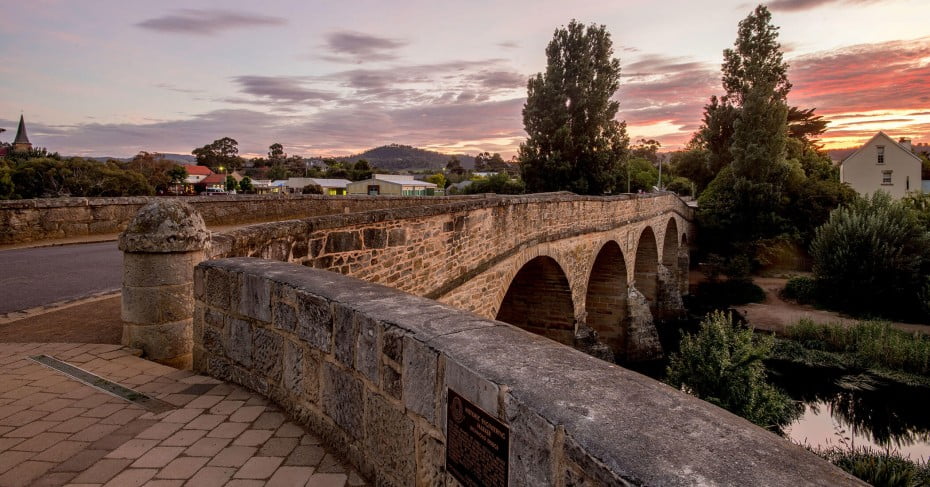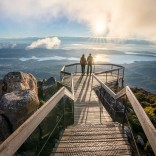Discover Hobart, Tasmania
Note: Before booking travel to Australia please check you meet all entry and transit requirements for your travel.
About our flights to Tasmania
Air New Zealand offers non-stop flights from Auckland to Hobart seasonally between October and March, with connections available from our domestic New Zealand Airports. You can choose the way you fly on all our flights to Australia.
Destination Tasmania - what to see and do
History, nature, art and food - Tasmania's got it all! Now you can fly non-stop from Auckland to Hobart to discover an island that's distinctively different.
As your plane descends to land at Hobart International Airport, you get hints of all the adventures that await you in Tasmania. Forest-clad peaks laced with hiking trails are separated by broad valleys dotted with food and wine experiences. Historic towns built along rivers are full of riveting stories from Tassie's intriguing past. And Hobart city on the Derwent River has some stand-out cultural experiences, including world-famous Mona (Museum of Old and New Art) on the outskirts of Hobart.
The ferry cruise to Mona (Museum of Old and New Art) is the perfect lead-in to awesome art experiences. Above and underground, Mona's exhibits are provocative, intense and often hilarious.


Explore Hobart, then hit the road
Start your Tasmanian adventure in Hobart, where it's easy to get around on foot, ferry, public bus, hop-on-hop-off tourist bus or by taxi (including Uber). This compact hilly city is oozing with heritage architecture, historic places and scenic lookouts. Urban sightseeing is complemented by a tempting choice of brew bars, gastro pubs, wharf restaurants and shopping precincts. After you've fully explored the highlights of Hobart, pick up a rental car for a scenery-packed road trip. The driving conditions are similar to New Zealand, but the sights and hikes are oh-so-very-Tassie.
Tasmanian art and history
If you love to chase art wherever you go, a compelling reason to visit Hobart is Mona (Museum of Old and New Art). The best way to get there is by ferry from the CBD waterfront; the refreshing 30-minute cruise is the perfect lead-in to some awesome art experiences.
Above and underground, Mona's exhibits are provocative, intense and often hilarious.
For fascinating storytelling from the past and a glimpse into palawa (Tasmanian Aboriginal) history and culture, check out the Tasmanian Museum and Art Gallery (TMAG) in the CBD. For a truly palawa perspective, join a takara nipaluna walking tour for truth-telling on the city streets.
Close to Hobart's vibrant waterfront is the Salamanca Arts Centre, where a time-scarred heritage building houses multiple art exhibitions and performance spaces. On Saturday, the Salamanca Market bursts into life with shopping and street food.
Tasmania's convict heritage is well preserved through a number of UNESCO World Heritage-listed sites. In South Hobart, the Cascades Female Factory Historic Site once operated as a prison for female convicts who were transported to Tasmania in the 1800s. Just half an hour east of Hobart, the town of Richmond has a gaol that dates back to 1825. At Port Arthur Historic Site on turrakana-Tasman Peninsula, a 1.5-hour drive from Hobart, the former penal settlement has become an intriguing open-air museum.

Where to eat and drink in Tasmania
Throughout Tasmania you'll benefit from the local obsession for good food, craft beer and cool-climate wine. The island also has a growing number of distilleries producing world-class single malt and gin. While you're in Hobart, check review sites for high-performing restaurants. Brooke Street Pier is one of the hot spots, with several water-view eating places, including Aloft with its seasonal menu of local produce and Maria for Mediterranean fare.
For good vibes and great pasta, head to the CBD's pocket-sized Pitzi or try the acclaimed Peppina, where Tasmanian produce gets an Italian spin. At Salamanca, head to Manky Sally's for craft beers and share plates. And if you want an extraordinary seafood experience, book a full-day Tasmanian Seafood Seduction cruise with Pennicott Wilderness Journeys. Cruises leave from Hobart's waterfront.
Beyond Hobart there are extraordinary food experiences that are destinations in their own right. For example: fresh oysters at Freycinet Marine Farm, a cooking class at the Agrarian Kitchen in New Norfolk or a paddock-to-plate long table feast featuring ethically produced pork at Fork it Farm.
For a liquid adventure, check out cider tastings in the Huon Valley at Willie Smiths, Frank's Cider or Pagan Cider. Lark Distillery, Tasmania's first-ever distillery, should also be on your radar. It offers tastings at its headquarters in Pontville and cellar door in Hobart. South of Hobart is Ewenique Tasting House, which is famous for its sheep whey spirits (vodka and liqueur) and sheep milk cheeses.

Outdoor activities and Tasmanian wildlife
The best way to appreciate Tasmania's unique natural environment is on foot, because 40% of the island is protected as national parks, reserves and UNESCO World Heritage areas. In total, the island has over 2,800 kms of walking tracks organised into more than 880 specific hikes. Here are some of the best day walks:
- If you're staying in Hobart, a day walk on kunanyi-Mt Wellington promises high-altitude scenery and a close-up look at a phenomenal natural formation called the Organ Pipes.
- In Freycinet National Park you can hike over a saddle between two pink granite peaks for jaw-dropping views of exquisite Wineglass Bay.
- In Cradle Mountain-Lake St Clair National Park the walk around Dove Lake reveals one of Tassie's most iconic scenes – the steep curves of Cradle Mountain rising up behind the lake. Nearby is Ronny Creek where you can see wombats grazing the hillsides like little marsupial cows.
- If you find yourself in Launceston, Cataract Gorge is really special - a mix of Victoriana and astonishing geology.
Multi-day walks include the six-day 65km Overland Track, which starts in Cradle Valley; the four-day Walls of Jerusalem Circuit, an alpine adventure with landforms of biblical proportions; and the incredible four-day Three Capes Track that skirts the edges of Australia's highest sea cliffs on Turrakana -Tasman Peninsula.
For a multi-day hike with a captivating palawa cultural theme, wukalina Walk is an award-winning four-day journey through wukalina (Mt William National Park) and larapuna (Bay of Fires).
While you'll probably encounter various forms of Tasmanian wildlife during your hikes – including wallabies, wombats, pademelons and echnidnas - the elusive Tasmanian devil is a nocturnal creature that's unlikely to show up on the path in front of you. To see Tassie's most famous little beast, visit a sanctuary to meet a group of breeding devils and quolls that are helping to repopulate the island's carnivorous marsupial population. Watching a group of devils feed is truly hair-raising.

Essential information

What is the weather like in Tasmania?
Hobart is at the same latitude as Kaikoura in New Zealand, so Tasmania has a climate and temperature range similar to the top of the South Island. There are four distinct seasons. In summer, average maximum daily temperatures are between 17 and 23°C. In winter, daily temperatures sit between 3 and 11°C degrees and you can expect snow in elevated areas. The west coast is wetter than the east coast. If you're wondering what to pack, our advice is to pack for the season but throw in an extra layer or two and be sure to include rainwear and hiking shoes.

What daily budget should I have for a Tasmanian holiday?
This will depend on your tastes and what you want to do. As a rough guide, not including air travel and hotels, you should allow about AUD $150 to $200 a day per person for food and entertainment.

What are the travel and transit requirements to visit Tasmania?
Please check you meet all entry and transit requirements for your travel to Australia.
